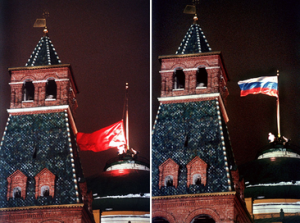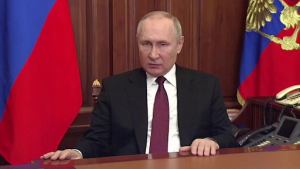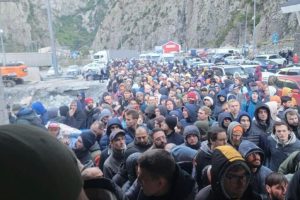Russo-Ukrainian War News Report
Post-Soviet Collapse, and the Ukrainian State
December 5, 2022
Post-Soviet Collapse, and the Ukrainian State

It all started because of the fall of the Soviet Union, after which a new Russian state was formed with a democratic constitution, and years of economic, social, and political reform in sight. Though several years of reform under the presidency of Boris Yeltsin were undergone, they were ultimately futile, and Yeltsin resigned on the 31st of December 1999, giving way to his then-Prime Minister, a former KGB officer, Vladimir Putin. Though originally acting, Putin would be elected to a full term in early 2000, and his reign of terror would begin.
With the war in Chechnya that had previously gone dormant, now resumed, it was clear that Putin’s policy was expansion, and the proclamation of Russia as the rival to the western world. Following the breakup of the Soviet Union, which itself was chaotic, many parts of the former Soviet arsenal were now spread throughout the Soviet republics, most notably in Ukraine which had one of the largest arsenals during the time that it held the weapons.

During Yeltsin’s presidency in 1994, the Budapest memorandum was signed between the United States, Russia and Ukraine, and saw the relocation of soviet nukes back to Russia in exchange for mutual guarantee of territorial sovereignty and protection.
For the first 20 years of the treaty’s existence, it was upheld, however following the Euromaidan revolution in Ukraine, which saw the overthrow of the pro-Russian government, Russia, now under the leadership of Vladimir Putin, seized and annexed Ukraine. Not long after, Russia began to fund pro-Russian rebels in the Donbass, most notably in Donetsk and Luhansk, instigating a civil conflict that continues to persist to this day. Ukraine’s future was bright when former comedian and actor Volodymyr Zelenskyy was elected president of Ukraine. Zelenskyy, who was elected on a platform of anti-corruption, and maintaining Ukrainian sovereignty, was originally unpopular due to his inexperience as a politician, and was involved in several international scandals most notably the Hunter Biden-Donald Trump scandal.

Timeline of Russia Ukraine war
In late 2021 and early 2022, the Russian military under the directive of Vladimir Putin, began to mobilise on the Russian-Ukrainian border on the basis of “military training”. Though signs of partial Russian withdrawal were seen in late January, they began to mobilise further in February. On the 24th of February 2022, Putin ordered the invasion of Ukraine by Russian forces in a so-called “Special Military Operation” to “denazify” Ukraine and its government. However, immediately after the order, much of the international community began to condemn Russia for its aggressive and unlawful actions in the Ukrainian state. The international community, most notably NATO, began to supply Ukraine with advanced weaponry such as the Javelin. Poland, and neighbouring countries accepted Ukrainian refugees who wanted to flee from their homeland that had been turned into a warzone.
Many members of the Russian Armed Forces both current and former fled their nation to fight for Ukraine, and likewise many people throughout the world joined the Ukrainian Foreign Legion to fight for Ukraine’s continued independence. When the invasion first began, Russia steamrolled through Ukrainian forces through Crimea, the Donbass, and even Belarus. They made it to Kyiv, almost furthering the disastrous effects of Chernobyl, but were stalled in the northern sector of the city, and were later pushed back in late March.
Since then, Russian forces were further pushed out of northern Ukraine, and pushed back into the Donbass, though they managed to maintain control over southern Ukraine. Since the start of the invasion, Russia began to utilise its media to spread propaganda by photoshopping images, and even creating deep-fakes to mimic Ukrainian president Zelenskyy. This attempt at propagandising the population has not been completely successful however as many Russians began to protest the war. One of the most infamous symbols to come out of the invasion was the usage of the latin letters “Z” and “V” by Russian forces despite their absences in the Russian alphabet. Originally meant to distinguish themselves from Ukrainian forces, “Z” later became a symbol supporting the invasion . Since then, it has been compared with the swastika used by the Nazi party in Germany during it’s reign, resulting in the prohibition of displaying the symbol in many European nations.

In late 2022, as Russia continued to lose against Ukrainian forces, Vladimir Putin ordered the heightened mobilisation of the Russian populace into the armed forces in an attempt to gain the upper hand against the Ukrainians, though this has yet to prove productive. The mobilisation would see many Russian citizens flee their homeland for neighbouring countries such as Georgia. Many of those who fled would also flee to the United States. Though as of currently, the invasion has been short, it has become the largest conflict in Europe since World War II, and saw Europe’s largest refugee crisis since the outbreak of the Syrian civil war in 2011.
Random fact:
As of October 25, 2022. In total, over 7.75 million Ukrainian refugees were registered across Europe alone.
When the war first started, Russia became the most sanctioned country in the world. Through it was thought that these sanctions would crush Russia’s economy, but instead it just led to rebrandings in the Russian market.
Meanwhile this was happening, the United states were sending in packages worth hundreds of millions of dollars to Ukraine (In total about $ 17.5 billion).
The second largest donor to Ukraine war the UK, which has contributed over £ 2.3 billion.

By Vladislav Sidorenko
Edited by Eric McGuire
Image Sources:
Before and After Russian McDonalds
